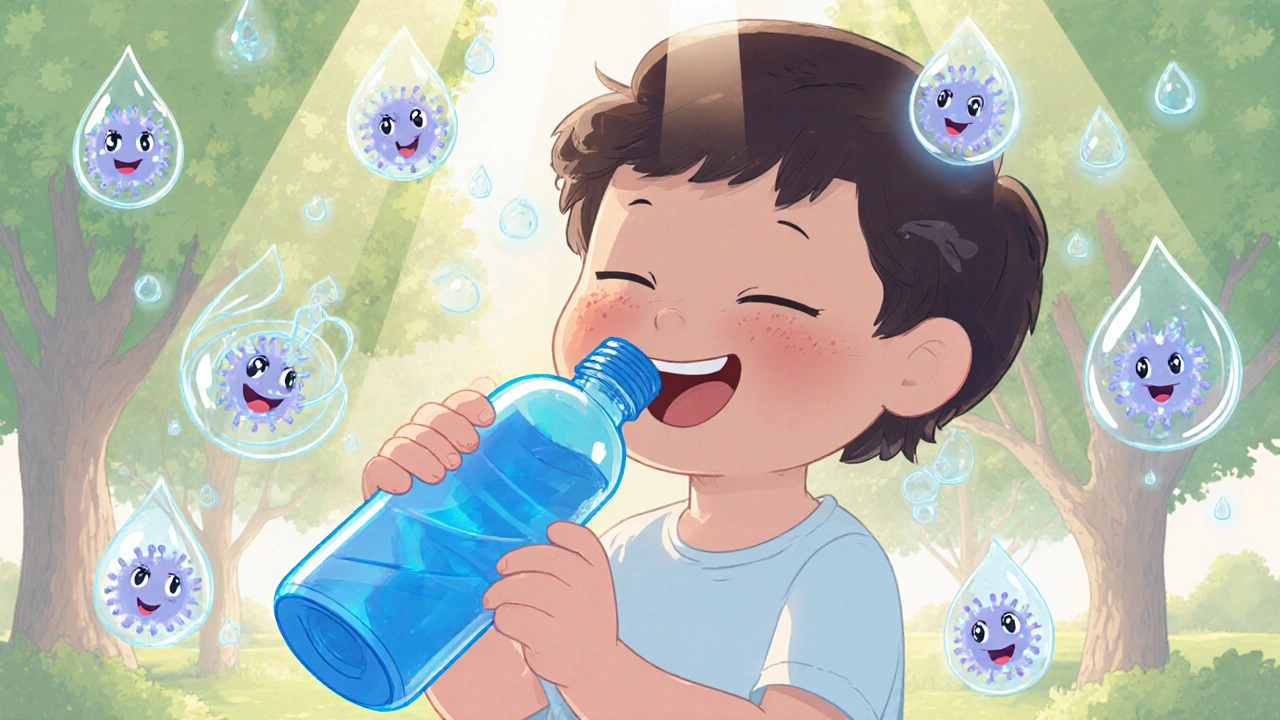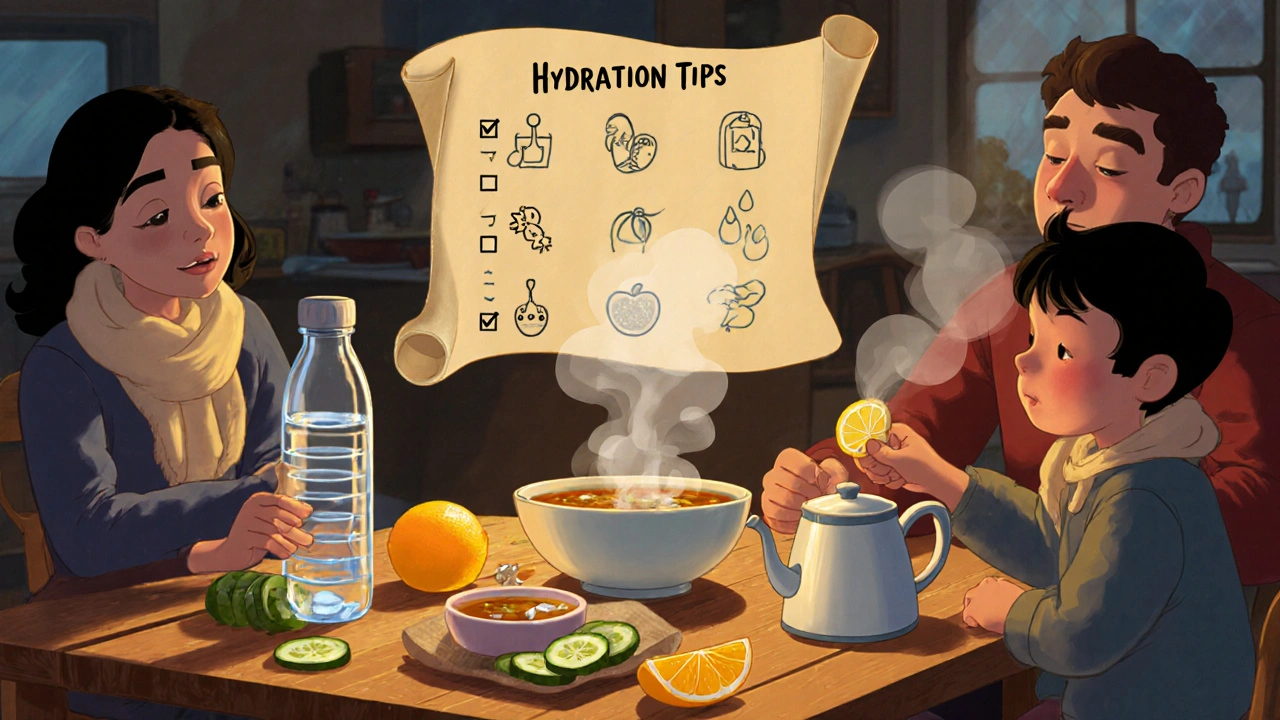Why Hydration Prevents Illness and Speeds Recovery
 Oct, 16 2025
Oct, 16 2025
Hydration Status Checker
This tool helps you assess your hydration status based on common symptoms. Select your current symptoms to see if you're well-hydrated or need to increase fluid intake.
Symptoms to Select
Your Hydration Status
Recommended Actions
Proper hydration is essential for keeping illness at bay and speeding up recovery. When you drink enough fluids, your body can run its defense systems smoothly, fever can break faster, and the nasty side‑effects of a cold or flu shrink dramatically.
What Hydration Really Means
Hydration is the process of maintaining adequate fluid levels in all of your body’s tissues and blood. It isn’t just about gulping water; it’s about balancing water with minerals, hormones, and the organs that regulate them.
How Fluids Support the Immune System
Electrolytes such as sodium, potassium, and magnesium act as tiny messengers that keep cells communicating. When you’re well‑hydrated, these electrolytes move freely, allowing white blood cells to travel quickly to infection sites.
The immune system relies on a stable blood volume to deliver antibodies and cytokines. Even a 2% drop in blood volume can slow down this delivery, giving viruses like the flu or COVID-19 a bigger window to multiply.
Hydration Helps Prevent Common Illnesses
- Cold and flu: Moist mucous membranes trap germs better, making it harder for them to invade.
- Gastrointestinal infections: Fluids keep the gut lining supple, reducing the chance that bacteria will breach.
- Urinary tract infections: Regular water intake flushes bacteria out before they settle.
Research from the British Nutrition Foundation (2024) showed that adults who met the daily 2‑litre fluid goal were 30% less likely to report a week‑long bout of flu symptoms.
When You’re Sick, Hydration Becomes Treatment
Fever raises body temperature, which speeds up fluid loss through sweat and rapid breathing. Replacing that loss prevents dehydration, a state that can intensify headache, dizziness, and even kidney strain.
Diarrhoea, a common symptom of food‑borne illness or viral gastroenteritis, can empty the body of both water and electrolytes within hours. Oral rehydration solutions (ORS) that combine clean water with a precise electrolyte ratio are proven to cut recovery time by half compared with plain water.
Even with COVID‑19, studies from the University of Oxford (2023) found that patients who stayed above 80% of their estimated fluid needs had milder lung inflammation and shorter hospital stays.

Practical Ways to Stay Hydrated
- Carry a reusable bottle and sip every 30 minutes, not just when you feel thirsty.
- Include foods with high water content - cucumbers, oranges, and soups - in every meal.
- When you’re feverish, add a pinch of salt and a squeeze of lemon to warm water; the salt aids electrolyte balance.
- Avoid excess caffeine or alcohol, which act as diuretics and increase urine output.
- Track intake with a simple app or journal; aim for 2‑2.5L per day for most adults.
Balancing Too Much and Too Little
While under‑hydration harms health, over‑hydration can dilute blood sodium, causing hyponatremia - a dangerous condition that leads to confusion and seizures. The sweet spot lies in listening to thirst cues, monitoring urine colour (light straw is ideal), and adjusting for activity, heat, and illness.
Quick Hydration Checklist
- Drink 8‑10 glasses of water daily; increase by 1‑2 glasses for every 30minutes of moderate exercise.
- Consume an ORS packet or a sports drink after bouts of vomiting or diarrhoea.
- Check urine colour each morning - aim for pale yellow.
- Replace lost fluids within the first 24hours of fever onset.
- Seek medical help if you notice swelling, rapid weight gain, or persistent low urine output.

Comparison: SymptomsvsHydration Status
| Symptom | Well‑Hydrated | Mild Dehydration (2‑3% loss) | Severe Dehydration (>5% loss) |
|---|---|---|---|
| Headache | Rare | Occasional | Frequent, throbbing |
| Fatigue | Low | Moderate | High, inability to focus |
| Heart Rate | Normal (60‑100bpm) | Elevated (+10bpm) | Significantly elevated (+20‑30bpm) |
| Urine Colour | Pale straw | Dark yellow | Amber or brown |
| Skin Turgor | Elastic | Slightly slow return | Very slow, may tent |
Bottom Line
Staying properly hydrated is one of the simplest, most cost‑effective ways to keep sickness at arm’s length and help your body bounce back faster when you do fall ill. Think of water as the grease that keeps the engine of your immune system running smoothly.
Frequently Asked Questions
How much water should I drink each day?
For most adults, 2-2.5litres (8‑10 cups) is enough, but you’ll need more if you’re exercising, in a hot climate, or fighting a fever.
Can I rely on tea or coffee for hydration?
Yes, but remember they contain caffeine, which can increase urine output. Balance them with equal amounts of plain water.
What’s the best way to replace electrolytes during illness?
Oral rehydration solutions (ORS) or a sports drink with a 1:1 sodium‑glucose ratio work well. Homemade ORS (½tsp salt, 6tsp sugar, 1L water) is also effective.
Is it possible to drink too much water?
Yes. Consuming several litres in a short period can lead to hyponatremia, which drops blood sodium and can cause confusion or seizures. Spread intake throughout the day.
Should I keep drinking if I have a sore throat?
Absolutely. Warm fluids soothe the throat and maintain moisture in the respiratory tract, reducing irritation and helping the immune response.

Tiffany Owen-Ray
October 16, 2025 AT 17:43Think of your body as a garden and water as the rain that nurtures every seed of immunity.
When you sip regularly, you keep the soil of your cells moist, allowing white blood cells to travel like diligent gardeners tending to each leaf.
The electrolytes act as tiny messengers, the whispering wind that carries nutrients to every corner of the ecosystem.
Even a slight dip in blood volume can silence those whispers, giving pathogens a chance to set up camp.
By maintaining a steady flow, you ensure that antibodies reach the front lines without delay, much like a well‑timed irrigation system.
Jill Brock
October 19, 2025 AT 15:10Water isn’t a miracle drug, you’re blowing this out of proportion!
Juan Sarmiento
October 22, 2025 AT 12:37Exactly, staying hydrated is like giving your immune system a reliable courier service.
Each sip helps maintain the volume needed for antibodies to travel quickly, so you’re not leaving the front line understaffed.
It’s a simple habit that pays big dividends when you’re fighting off a cold or flu.
Patrick McVicker
October 25, 2025 AT 10:03Gotcha, and don’t forget that a little lemon or a pinch of salt can turn plain water into a tiny electrolyte boost 😊.
Liliana Phera
October 28, 2025 AT 07:30From a philosophical angle, water mirrors the balance we seek in life; it’s both the medium and the message.
When you’re depleted, your thoughts fog, and your body’s defenses wobble, echoing the chaos of an unsteady mind.
Replenish the fluid, and you re‑anchor both body and spirit.
Poorni Joth
October 31, 2025 AT 04:57Honestly, if u cant even drink 2 lits of water a day u shouldnt be comaparing urself to a health guru, its basic self care lol.
Yareli Gonzalez
November 3, 2025 AT 02:23Staying hydrated is a simple act of self‑respect; it’s one of the easiest ways to show up for yourself and others.
Alisa Hayes
November 5, 2025 AT 23:50I appreciate the thorough breakdown, especially the practical checklist.
Encouraging people to track intake with an app makes the habit feel tangible, which is key for long‑term adherence.
Mariana L Figueroa
November 8, 2025 AT 21:17Hydration is cheap. It works. Keep it steady.
Diane Helene Lalande
November 11, 2025 AT 18:43Using foods with high water content, like cucumbers and soups, is a smart way to stay hydrated without constantly reaching for a bottle.
Manju priya
November 14, 2025 AT 16:10For those preferring a structured approach, consider logging each glass in a journal; the visual record reinforces consistency 😊.
Jesse Groenendaal
November 17, 2025 AT 13:37People need to remember that hydration isn’t just about drinking; it’s about balance and not overdoing it either.
Persephone McNair
November 20, 2025 AT 11:03In clinical terms, maintaining plasma osmolarity within the optimal range is crucial for immune cell trafficking and cytokine diffusion.